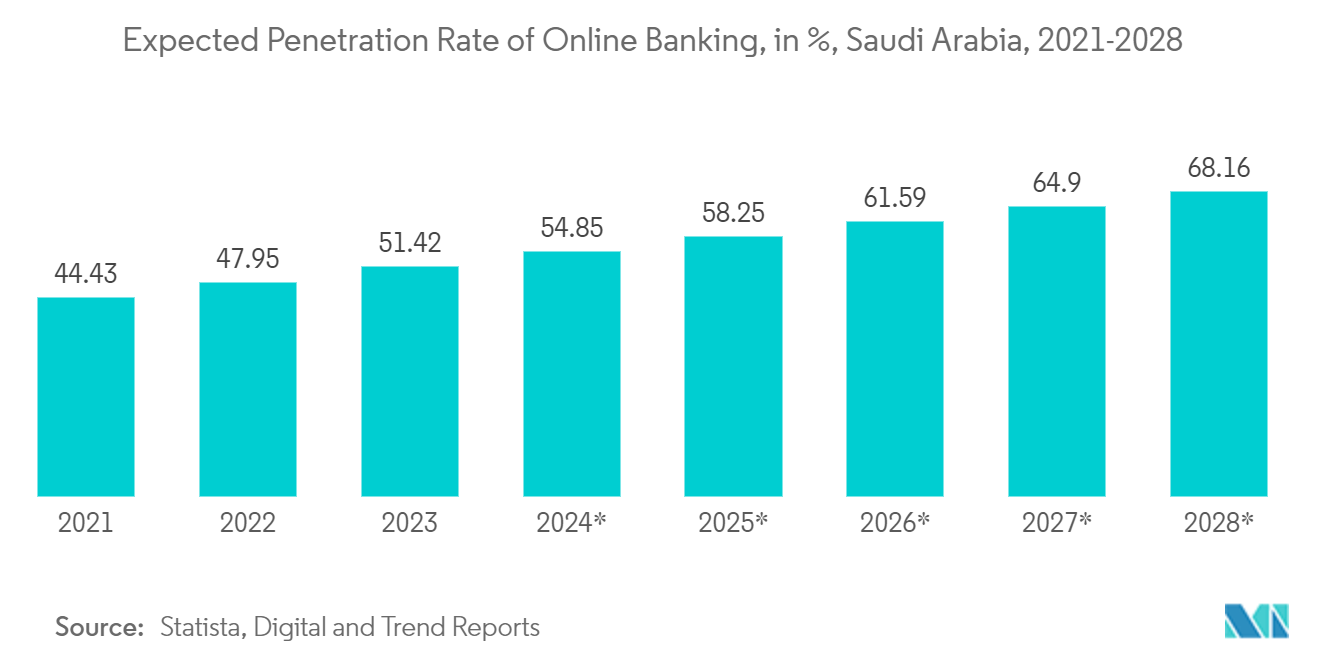Market Trends of Saudi Arabia Data Center Rack Industry
BFSI To Hold Major Market Share
- Saudi Arabian banks stand to remain on a profitable path in 2023, with corporate lending continuing to drive credit growth in the sector. The Saudi Central Bank (SAMA) has been a proponent of innovation and development in the financial sector since the launch of Saudi Arabia's financial sector development program, one of the pillars of Vision 2030, in 2017.
- The move towards digitalization was most evident in the granting of licenses to the two first fully digital banks in Saudi Arabia in 2020. The move included Saudi Telecom's STC Pay being renamed STC Bank with a capital of SAR 2.5 billion (USD 670 million) and Saudi Digital Bank (SDB) gaining a capital of SAR 1.5 billion (USD 40 million). These new licenses embody the country's desire to become a financial hub and increase the efficiency and penetration of its banking system.
- Saudi Arabia has licensed three entities since 2021. STC Bank, which boasts eight million retail customers and more than 120,000 merchants within its network, is currently converting all its activities and functions from an e-wallet to a digital bank.
- Further, the buy-now, pay-later strategy has enabled consumers to shift to online purchases. For instance, 10% of Saudi Arabian consumers prefer the BNPL payment option for online shopping. Additionally, the Saudi Arabian Monetary Authority (SAMA) started developing a regulatory sandbox environment in February 2019 to test fintech startups in the nation. In addition, MCIT has established an innovation hub that intends to serve as a technological incubator, attract private and governmental partnerships, and link business owners with all pertinent players in the Saudi startup ecosystem.
- Banks in Saudi Arabia intend to spend a lot of money on digital during the next few years. The Financial Sector Development Program (FSDP), which aims to provide a strong financial services sector in Saudi Arabia that is both modern and innovative, is another way the government supports the fintech sector. As a part of this, the country wants to triple the number of fintech companies it currently has by 2025 (from 82 to 230), and it wants to convert 70% of all financial transactions being made to digital within the next three years.
- Overall, the demand for data center racks is expected to increase with increasing data center services as a result of increased digitalization in the financial sector.

Full Rack is Expected to Grow Significantly
- In Saudi Arabia, due to the increase in the number of data centers and the preference for hyperscale and wholesale data centers in the country, the need for the storage of data has created a need for increasing installation of full racks.
- Saudi Arabia is expected to cater to investments of up to USD 18 billion to construct sizable data centers across the Kingdom. Due to the nation's growing digitization and significant foreign direct investments, demand for tier 4 infrastructure will increase, leading to demand for full racks.
- Cloud computing, software platforms, social media, and content delivery are some of the primary drivers directly affecting hyperscale data center expansion. With over 29.5 million users in 2022, social media has developed into a potent instrument that generates large amounts of data in the form of blogs, tweets, updates, photographs, and videos.
- Rapid public cloud-based technology adoption will help hasten the country's digital transition while protecting mountains of data. With enticing investments from cloud providers such as Google and Oracle, the data center business has started to pick up steam. For instance, Oracle will work with NEOM Tech & Digital Holding Co. as the first tenant in the hyperscale data center at NEOM to serve Saudi Vision 2030. The data center will house Oracle Cloud Infrastructure (OCI), which would offer a high-performing, resilient platform for cloud services.
- Saudi Arabia is in a prime position to expand both its general and ICT-focused start-up ecosystems. With over 96% of Saudis owning smartphones, the country's young, technologically savvy population makes up a sizable local digital customer base. The above factor is expected to increase the demand for full racks.


